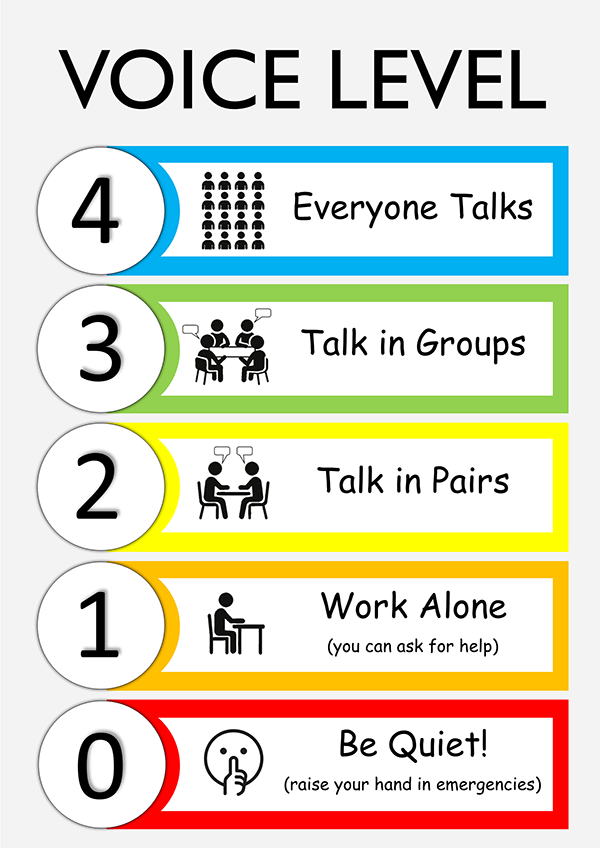Managing classroom noise isn’t just about keeping things quiet. It’s about creating the right kind of talk at the right time. In English language classrooms, especially in EFL settings like Taiwan, teachers often want students to engage in partner or group discussions to practice speaking. But without clear expectations, these moments can turn into total silence or off-topic chatter.
That’s where visual tools like voice level charts come in. These charts help students understand what kind of talking is allowed during each part of the lesson—whether it’s whispering with a partner, chatting in a group, or staying silent during a quiz.
It’s worth noting that many Taiwanese students are used to teacher-centered classrooms. Student-to-student interaction might feel unfamiliar, and it can take time for them to feel comfortable with more open speaking tasks.
That’s why consistent visual cues and gentle guidance are so important when building a classroom culture that supports meaningful English use.
What Is a Voice Level Chart?
A voice level chart is a simple classroom management tool that visually communicates how much noise is acceptable at any given time. It’s usually a poster or board with 4–5 clear levels, each assigned a number and a label. For example:
- Level 4 – Class Discussion: Everyone can talk and respond together.
- Level 3 – Group Work: Talk with your group only.
- Level 2 – Pair Work: Talk quietly to your partner.
- Level 1 – Independent Work: Be quiet, but it’s still OK to ask for help.
- Level 0 – Silent Work: No talking (e.g., test time).
This chart helps students understand and adjust their behavior based on the activity, without the teacher constantly needing to remind them.
The levels can be adjusted or renamed to match your teaching style, but the idea remains the same: give students a reference to know when and how to use their voices appropriately.
Some teachers post this chart on the blackboard with a magnet or arrow to show the current level. Others create versions with local language support or visual icons for younger learners.

Teacher Connor’s Red and Green Cup Method
One simple but highly effective technique comes from Teacher Connor. He gives each group a stack of two paper cups, one red, one green, and places them upside down on the table.
When students are expected to talk and collaborate, the green cup goes on top. When it’s time to focus quietly, he flips it so the red cup shows. No need to interrupt or raise your voice. Students can simply look at the cup to know what’s expected.
This visual signal is especially useful during station activities or projects, when different groups may need to operate at different voice levels. It gives students a sense of autonomy and helps them stay on task without constant reminders.
If you’re using a voice level chart with more than two levels, it’s possible to expand this system. For example, you could add more cup colors or labels to match the full range: partner talk, group work, quiet individual time, and so on.
But even just red and green can go a long way in helping students understand and manage their own behavior.
Challenges in Taiwanese Classrooms
In many Taiwanese classrooms, students are used to teacher-centered instruction. They may spend most of the day listening, reading, or responding to questions one at a time. So when a teacher encourages pair work or small group discussion, the results can be unpredictable.
Sometimes students will go silent, unsure what to say. Other times, they might start chatting in Chinese or drift off task. This doesn’t mean they’re being uncooperative. It usually means they don’t have much experience with this kind of interaction.
Building a classroom where students feel comfortable speaking takes time. It helps if you and your co-teacher agree on routines and expectations. If students know what kind of talk is expected, and that they won’t be put on the spot or laughed at, they’re more likely to engage.
Just like any other classroom habit, meaningful student interaction grows stronger with consistency and support.
Tips for Building a Talk-Friendly Classroom
Getting students comfortable with speaking doesn’t happen overnight. Here are a few ways to create an environment where English interaction feels safe and doable:
- Start small: Use short, structured pair tasks with clear sentence frames or prompts. Even just practicing, “What’s your favorite ___?” is a good beginning.
- Model the interaction: Show students what a successful exchange looks and sounds like before asking them to try it. Co-teaching is helpful here. One teacher can be the model while the other guides the class.
- Use routines: Repeating familiar activities (like Think-Pair-Share) helps students focus on the content rather than the process.
- Catch students doing it right: Notice and praise students who are on task, trying their best, or using English—even if it’s not perfect.
- Redirect gently: If a group is off-task or using too much Chinese, pause and remind them of the expectations. A quick visual reminder (like changing the cup color or pointing to the voice chart) can help without stopping the whole class.
- Coordinate with your co-teacher: A consistent approach from both teachers makes a big difference. Talk in advance about how to support speaking tasks and what to do if things go off track.
Final Thoughts
Creating a classroom where students feel comfortable speaking English takes time, patience, and clear systems. Tools like voice level charts and Teacher Connor’s red-and-green cups give students visual reminders of what’s expected and help reduce the need for constant correction.
It’s normal for students in Taiwan to be unfamiliar with pair or group interaction at first, especially in English. But with consistent routines, clear expectations, and support from your co-teacher, students will gradually grow more confident.
The goal isn’t perfect behavior or perfect grammar. It’s about building a space where communication can happen and grow.
